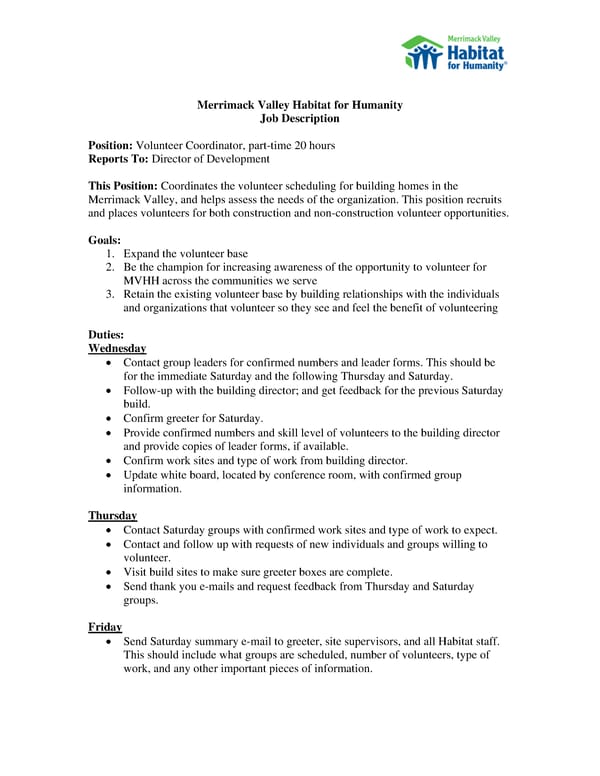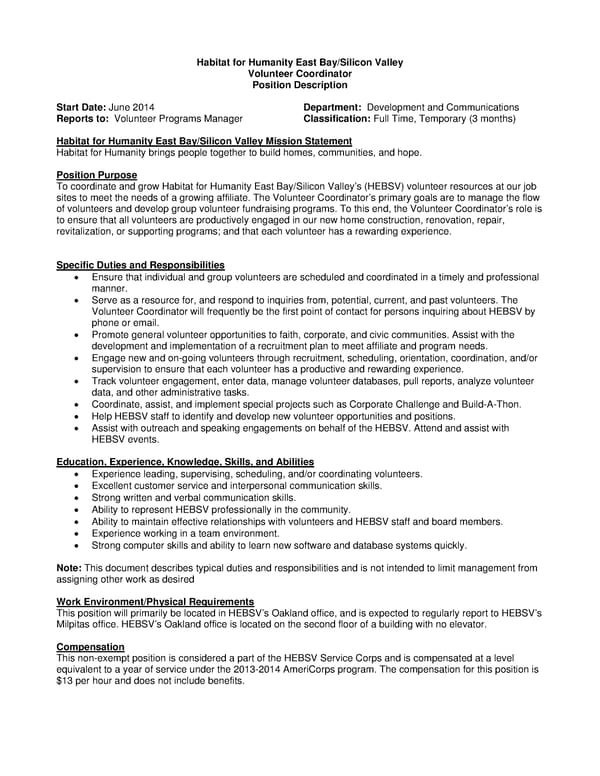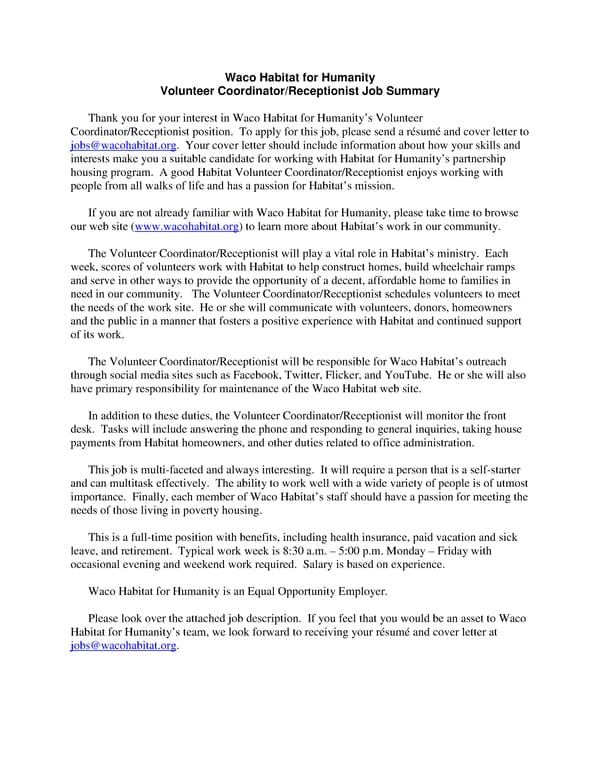Habitat for Humanity Volunteer Coordinator
Best practices, tools and other resources





Published by Salvador Briggman. Find him on Twitter.
Crowdfunding for social causes is quickly gaining in popularity. These sites are redefining how NGOs, non-profits, and student organizations raise money for events and charitable causes. I've included a list of the top ten social sites below. Don't forget to check out 5 Ways Nonprofits Can Use Crowdfunding and Non-profit Crowdfunding vs. Peer to Peer Fundraising.
1. Razoo: "a movement of people who want to make generosity a part of everyday life." Over 14,000 nonprofits have used this platform to raise around 100 million.
2. Causes: For people who want to change the world. Categories vary from disaster relief efforts to human rights. Causes has raised more than 30 million for non-profits.
3. Buzzbnk: A UK platform that supports social entrepreneurs and innovators. "Positive People Backing Bright Ideas."
4. StartSomeGood: StartSomeGood empowers "social innovators," and forwards the trend of social entrepreneurship. It is a relatively new social site.
5. Crowdrise: Named the "Top 25 Best Global Philanthropist." Since 2009, Crowdrise has helped bring together volunteers and philanthropists to spread the call of service.
6. CauseVox: Is a NYC startup social site that focuses on helping small to medium sized non-profits raise funds and have a social impact.
7. Kickstarter: A project crowdfunding website that any organization or individual can use to finance their event or project.
8. Indiegogo: An international crowdfunding site for creative types that can also be used to raise money for charity and non-profit organizations.
9. Rockethub.com: A crowdfunding platform used by all types of organizations and individuals ranging from scientists to philanthropists.
10. Pozible.com: An Australia-based website that encourages creative projects and ideas. This website can also be used for charity purposes.
Weekly Success Tips
Want to receive awesome valuable resources that will help you run a successful Kickstarter, Indiegogo, or other type of crowdfunding campaign? Join 3,000+ other readers working hard to make their dream a reality.
The top three things to do after making a fundraising page
Start by making a donation to your own fundraising page. Other people are more likely to donate to your page when they see that someone has already contributed. Donating some of your own money also demonstrates to potential supporters that you are serious about helping the cause.
Personalize your fundraising page, by adding your own text, pictures, or video. Remember, your potential donors will be interested in the cause, but they are primarily interested in you. Make sure you tell them why you are getting involved and what your connection to the cause is (it doesn't have to be long).

Send individual emails to your five closest contacts and ask them for donations first. Getting your "inner circle" to donate to your page will help you build up some momentum. It's also good to start with the people you are most comfortable with!
The Best Way to Reach out to Friends and Family
Think about your fundraising strategy like peeling an onion from the inside out. The best fundraisers start by asking their closest contacts first (the core) and progressively working outward to more distant contacts (the outer skin).
? Why would you do that
- Your closest contacts are the ones most likely to donate, more remote contacts are less like to donate.
- Studies show that as you make progress towards your fundraising goal people become more and more likely to donate to you (success breeds success!).
- When you start with your closest contacts and work outwards, you ensure that you build up progress from your core supporters before you reach out to the people who are less likely to donate.
- This means maximizing your chances of successfully meeting (or exceeding) your fundraising goal!
Getting Started Action Items
A good starting point plan usually looks something like this:
- Day 1 Email #1: Send to 10 very close contacts (family and your closest friend or two).
- Day 2 Email #2: Send to 10-50 close contacts (your entire circle of good friends).
- Day 3 Email #3: Send to as many other contacts that you feel comfortable sending a message to (co-workers, friends of friends, distant relatives, your entire address book, etc.).
- Day 4 Social Media & Beyond Promote via Social Media to anyone who will listen.
And, don't be a afraid to send follow up emails! Your close friends and family won't mind hearing from you a few times.
How to Write Your Emails to Friends & Family
There is no perfect formula for writing an email asking family and friends for donations, but there are some best practices to guide you:
p Writing a General Email
- Start by explaining your connection to the cause and why it's important to you. Describing how the cause has touched your life is probably the most important element of your message.
- In a sentence or two explain the good work the organization is doing to advance the cause. This helps potential supporters understand where their money would be going and what it would be used to accomplish.
- Be clear to potential supporters about what you are looking for; make a direct ask for financial support
- Include a link to your fundraising page.
- Thank your contacts for their time and support.

. Writing to your Closest Contacts
- You know your closest contacts better than anyone does. Don't feel like you have to stick to a predefined formula
- If a one line message is going to work, go ahead and do that. If a longer personal message will work best, do that.
- Just make sure you include a direct request for support and a link to your fundraising page at the end of your message
Always Remember
When you're writing to your contacts, just be yourself. If something feels forced or inauthentic, scrap it.
The best ways to use Facebook and Twitter to fundraise
Start fundraising through G Facebook and U Twitter after you've sent out your initial batch of emails.
- Get started on G Facebook by tagging the people that have already donated to you and thanking them for their donations. When you tag someone your post gets shared in your activity feed and the other person's activity feed too. This also sets the frame that people are already donating to your page (remember success breeds success!).
- Set internal goals (e.g. 200 dollars by the end of week two, 400 dollars by end of week four, etc.). Use your social media accounts to give updates of your progress towards each goal and ask for people to help you get over the next hurdle.
- Don't make every post an "ask". Share inspiring news stories or other positive anecdotes about the cause too!
- Consider offering your own gifts to friends and family who help you reach your goal. It doesn't have to be anything extravagant, just a token of your appreciation.
How to follow up with people who don't respond initially
By setting internal goals (e.g. 200 dollars by end of week two, 400 dollars by end of week four, etc.) you accomplish two things. First, you create more urgency when you ask friends and family for support. And second, you give yourself a built in reason to follow up.
- Reach back out to non-responders when you're approaching one of your internal goals. If you set a few internal goals, you can plan on sending a couple follow up emails. Remember people can easily miss or skip over your initial outreach!
- Include progress updates in your follow up messages and consider including any inspiring stories or personal anecdotes you have about the cause.
- Remember to continue using social media! Social media is a softer medium for communicating with your contacts and it's more acceptable to frequently post updates in those channels.
How to successfully start and manage a fundraising team
Fundraising teams range in formality. If you're running a race or doing a walk together, there will probably be a bit more involved than if you are just fundraising online as a group. Either way, here are some starting tips for creating a successful team:
- After you create your team fundraising page, you need to recruit your team members. You can start by emailing or calling the people you think might be interested in joining you. Follow that up by making a few requests through Facebook and Twitter.
- As people join your team, send them a quick email to thank them for joining and helping the cause.
- When you've got most of your team members signed up come up with a reasonable team fundraising goal. You can do this on your own or after getting feedback from team members (either way, just use your best judgment of what is achievable).
- Send an email out to the group thanking them again and communicating the team goal.
- Send periodic updates about the team's progress (this prevents slacking and keeps everyone committed) and encourage people to share ideas about what's working best.
- Be supportive and send along words of encouragement to team members as you work together towards the goal.
What it takes to be a successful fundraiser
- A belief in the cause
- A commitment to following through
- And a dose of individual creativity
Good Luck & Have Fun!
LocalCatering.com serves you with quick and easy access to great caterers in your area.
Here at LocalCatering.com, we connect you with the best catering services from Los Angeles to New York and everywhere in between! Party caterers in Boston, corporate caterers for your business event in Dallas, or the perfect caterer for your San Diego wedding, let us help you find the caterer that meets all the needs of your special event.
We supply you with an easy to fill out form to specify exactly what you need from your caterer. Be as specific as possible when filling out the form and include any special requirements you may have. Caterers can then construct menu options and cost estimates for your particular event. Quotes are specified to meet the needs of your event and are typically on a price-per-guest basis.
Members of LocalCatering.com are held to a gold standard. We collect the reviews of our vendors to assure high quality and satisfaction. Vendors that do not meet our standards in quality and customer reviews are removed from the LocalCatering.com lists. Be sure to check the resources of your prospective caterer.
Here are a few helpful hints while researching your caterer.
- BBB Ratings - Check the caterer's Better Business Bureau rating for additional information on the company.
- Look at pictures from past events - Attention to the presentation of the food and decorations will help determine if the caterers style will meet your preferences.
- References - Check around for additional reviews and references of the catering service. Reviews are extremely important for a caterers image. Reviews reflect customer satisfaction and quality of the catering business.
Questions to ask Catering Services
When planning for your big business event, holiday party or wedding, there's specific questions to ask your prospective caterer that are extremely helpful in finding the right one for you.
- Ask about the caterers availability on the date of your event.
- Does the caterer have menu samples to review? Do they specialize in a particular types of food?
- Will the caterer offer taste-testing before hire?
- Does the caterer offer table settings? Ask about other favors and non food items they may have to offer.
- Ensure proper licensing, insurance and health department standards of the caterer.
- Where will the food be prepared? Will there be onsite facilities at your event for the caterer to use?
- Will your caterer bring their own equipment?
- Ask about banquet halls, photographers, florists and entertainers they may have to suggest for your event.
- Does your caterer provide a wait staff? Ask the recommended number of waiters for your particular event and discuss the waiters uniform attire as well.
- If you would like alcohol served at your event, be sure to discuss with your caterer on matters such as providing a bar and any corkage fees.
- Caterers often provide extras in their packages. Be sure to clarify with your caterer exactly what you will be receiving in your specific package!
With these questions in mind and the help of LocalCatering.com, finding the perfect caterer for you event has never been easier. Get started today!

Catering and Event Articles
STEP 2
Fill Out the
Corresponding Form
STEP 3
Get Matched with
Service Providers
in Your Area



